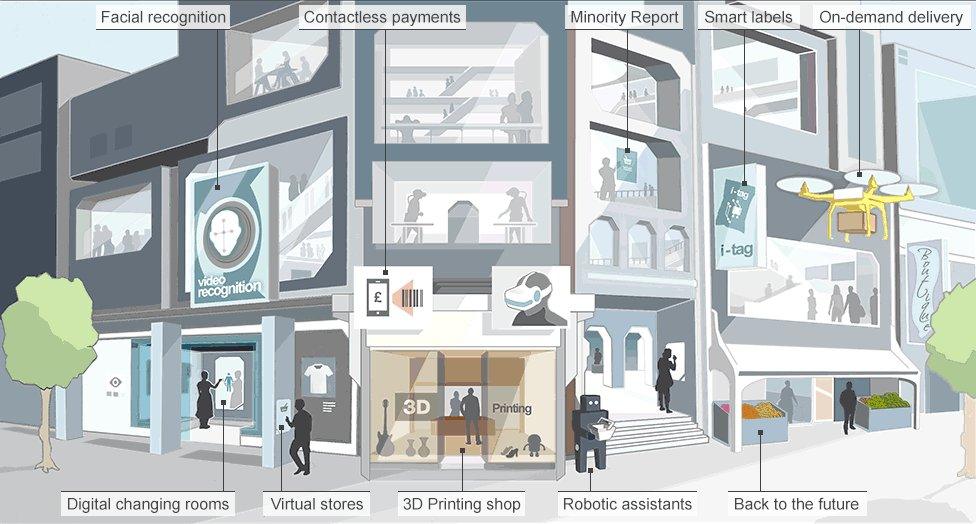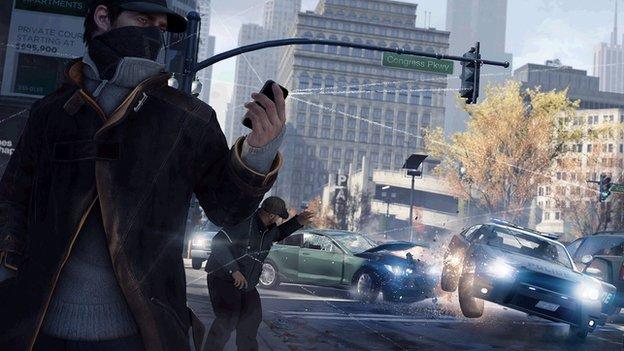Tomorrow's cities - future of shopping
- Published

Go down to your local High Street and it probably looks like every other one you have ever visited - full of coffee shops, mobile phone stores and discount retailers. There may also be many boarded-up shops - victims of the economic downturn and the popularity of online shopping.
So how will our High Street fare in the next decade and will we still be going there to browse on a Saturday afternoon?
Digital changing rooms
Firms, such as Magic Mirror, are developing virtual mirrors which allow people to try on clothes via a projected image of themselves on screen. Body sensors map their shape and virtual clothes can be added via a touchscreen.
Meanwhile US men's clothing store Hointer already offers shoppers the chance to scan the QR code on a clothes label, pick the size via an app and the chosen item will drop into a chute in a changing room, speeding up the process of shopping.
Virtual stores
Virtual stores could pop up anywhere with large touchscreens offering consumers a range of goods or virtual displays in stores showing stock that there is no room for on real shelves.
Tesco set up a virtual shop in the Seoul metro allowing passengers to order their groceries via digital shelves that looked just like the real ones and were full of produce that could be scanned into their smartphones on the way to work. By the time they got home, the goods had been delivered.
3D printing shop
3D printing is likely to become a reality on every high street allowing people to touch a screen, download a particular design and have a unique product made for them as they wait.
Experts such as Dr Greg Gibbons from Warwick University predicts that 3D printing shops will replace stores that currently offer photocopying and printing services. Other think we will have 3D printing booths rather like the telephone kiosks of old.
Robotic assistants
In shopping centres in South Korea robotic assistants are already on hand to help shoppers find the right stores but it is behind the scenes that robots will really come into their own, stacking shelves, checking inventory and keeping an eye on stock levels and freshness.
Andyvision is a stock-taking robot developed at Carnegie Mellon University. He scans the shelves to generate a real-time interactive map of the store as well as conducting a detailed inventory check and alerting employees if anything is out of place or stock is low.
Back to the future
Not everyone thinks the future of the high street will be hi-tech. Academic Laura Vaughan believes that they may return to the days of a local butcher, baker, craft stalls and farmers' markets.
People will find alternative way to populate high streets and suggestions that they are dying in the face of online competition are wrong, she thinks.
On-demand delivery
Click and collect - where people buy online and collect from lockers installed in offices, tube stations and other locations - will grow in popularity as will on-demand personal assistants such as WunWun which offer in-an-hour delivery services via mobile apps.
Meanwhile Amazon is taking plans to deliver via drone seriously and has recently applied for a flying licence from the US Federal Aviation Authority.
Smart labels
Firms like Norwegian Thinfilm are starting to embed electronics in labelling as the cost of doing so falls dramatically. The smart labels contain sensors, displays and uses near-field communication to tell customers whether their pint of milk is fresh or if a product complies with international standards.
In future shelves will be packed with sensors, highlighting the best wine for go with the ingredients in your trolley or highlighting products containing peanuts to a shopper with an allergy.
Minority report
In future there will be little privacy in shops. Sensors around the store will collect information about how many customers are visiting and where they are spending the longest time.
And more and more information will be communicated from stores to users' phones. Shops on Regent Street in London have installed iBeacons - which use Bluetooth to beam personalised offers and suggestions to customers about products they might want to buy.
Contactless payment
Forgotten to take your wallet or purse to the shops? Don't worry - in future people will pay for goods via their smartphones.
In France customers of supermarket chain Auchan and DIY store Leroy Merlin recently trialled payment via fingerprint scanners. Their biometric data was stored on a payment card which used near-field communication to interact with the till.
Facial recognition
Emotient, a San Diego firm, is already using facial expression recognition software to gauge customers' moods as they go in and out of shops and to track reactions to different packaging and brands.
Tesco has trialled a facial scanning app to target ads to customers in queues based on age and gender. The app proved highly controversial and raised questions about how intrusive such technology could become.
- Published11 September 2014

- Published9 September 2013
